List of equipment of the Iranian Army
From Wikipedia, the free encyclopedia
This page includes weapons used by both the Ground Forces of the Islamic Republic of Iran Army and the Ground Forces of the Islamic Revolutionary Guard Corps.
From 1925 to the Iranian Revolution in 1979, Iran was primarily equipped with Western hardware and equipment. Cases exist where Iran was supplied with equipment before it was even made standard in the country that developed it (for example the US F-14 Tomcat jet, and the British Chieftain tank). Primary suppliers included the United States, Britain, France, West Germany, Italy, Israel, and the Soviet Union.
The post-revolution sanctions and the Iran–Iraq War had a dramatic effect on Iran's inventory of Western equipment. Under the pressures of war, supplies were quickly exhausted and replacements became difficult to come by. The war forced Iran to turn towards Syria, Brazil and China to meet its short-term military needs. Initial developments in military technology were carried out with the support of China, North Korea and Russia to lay the foundations for future industries.
Iranian reliance on these countries has rapidly decreased since the 2010s in most sectors whereby Iran has gained almost total independence. However, in some sectors such as aerospace, Iran is still greatly reliant on external sourcing. Iran has developed the capacity to reverse engineer existing foreign hardware, adapt it to its own requirements and then manufacture the finished product. Examples of this are the Boragh IFV. In an attempt to make its military industries more sustainable Iran has also sought to export its military products.
Infantry gear
| Model | Type | Image | Origin | Notes |
|---|---|---|---|---|
| Uniform equipment | ||||
| Ruyin-1 | Body armor |  |
Standard body armor of the Islamic Republic of Iran Army professional units. Offers level NIJ IIIA protection with soft armor installed. | |
| Ruyin-2 | Body armor |  |
Second most widely used body armor of the Islamic Revolutionary Guard Corps, alongside the very similarly designed Ruyin-3. Offers high level NIJ IV level protection with plates installed. Also used by FARAJA and NEDAJA marines | |
| Ruyin-3 | Body armor |  |
Standard body armor of the Islamic Revolutionary Guard Corps and Basij units, offers high level NIJ IV level protection with plates installed. Also used by FARAJA | |
| Ruyin-5 | Body armor |  |
Standard light plate carrier of Islamic Revolutionary Guard corps. Also used by FARAJA | |
| Derivative of PASGT helmet | Kevlar ballistic helmet |  |
Slowly phasing out the M1 helmet in service as standard helmet. | |
| Derivative of Advanced Combat Helmet helmet | Kevlar ballistic helmet |  |
Standard helmet across military, except for SOF and Islamic Republic of Iran Army conscripts. | |
| Derivative of FAST MT helmet | Kevlar ballistic helmet |  |
Standard helmet for Special Operations units across the Iranian Military | |
| M1 helmet | Steel helmet |  |
Used by Islamic Republic of Iran Army conscripts. | |
| MOLLE type vest[1] | Load bearing vest |  |
Used across all units.[1] | |
| Copy of Ephod combat vest |  |
[2] | ||
Infantry weapons
Summarize
Perspective
Firearms
| Model | Cartridge Type |
Image | Origin | Notes |
|---|---|---|---|---|
| Pistols | ||||
| PC-9 Zoaf | 9×19mm Semi-automatic pistol |
 |
Iranian version of the SIG Sauer P226 platform. In service with the Police and Army.[3] | |
| CZ 75 | 9×19mm Semi-automatic pistol |
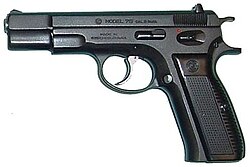 |
Used by 65th Airborne Special Forces Brigade. | |
| Glock 19/Glock 17 | 9×19mm Semi-automatic pistol |
 |
In service with IRGC. Iranian copy named Kaveh 17 also in development.[4] | |
| FN Hi-Power | 9×19mm Semi-automatic pistol |
 |
In service with IRGC.[5] | |
| Colt M1911A1 | .45 ACP Semi-automatic pistol |
 |
In service with the Army.[6][7] | |
| Submachine guns | ||||
| Tondar (MPT9, MPT9S), Tondar Light (MPT9K) |
9×19mm Submachine gun |
 |
Heckler & Koch MP5 variants produced under license under the trade names of Tondar,[8] and MPT9. | |
| Beretta M12 | 9×19mm Submachine gun |
 |
[9] | |
| Star Model Z84 | 9×19mm Submachine gun |
 |
Amphibious submachine gun is used by IRGCN frogmen.[10] | |
| Uzi | 9×19mm Submachine gun |
 |
[11] | |
| Shotguns | ||||
| Hatsan Escort MPA-TS | 12-gauge Shotgun |
Used by IRGC during Mahsa Amini protests.[12] | ||
| Battle rifles | ||||
| Heckler & Koch G3A6 | 7.62×51mm Battle rifle |
 |
Artesh service rifle.[13] Heckler & Koch G3A3 and G3A4 rifles produced under license.[14] Iranian G3A6 differs from original G3A3 in having a dark-green slimline handguard, fixed stock, and trigger pack. There is also a retractable stock variant (G3A4). | |
| Masaf 2 | 7.62×51mm Battle rifle |
 |
Battle rifle version of the first Masaf variant. It was unveiled in 2021 and has been issued to Army Ground Forces 35th Rapid Reactionary Brigade by 2025.[15][16] | |
| Zulfiqar Z1 | 7.62×51mm Battle rifle |
 |
Unveiled in 2017. Yet to enter service.[17] | |
| Azarakhsh | 7.62×51mm Battle rifle |
 |
Iranian-designed bullpup variant of the G3 platform. Was not adopted by the armed forces.[citation needed] | |
| Assault rifles | ||||
| KLS KLF KLT |
7.62×39mm Assault rifle |
 |
Standard issue assault rifle of the Army and IRGC. Iranian versions of the AK platform modeled after the Type 56, Mpi kms 72 and the AKM.[citation needed] | |
| AK-133 | 7.62×39mm Assault rifle |
 |
IRGC service rifle. AK-103 rifle produced under license under the name AK-133, first unveiled in March 2018. An undisclosed amount of AK-103 rifles for use by special forces were purchased from Kalashnikov Concern and delivered in 2016.[18][19] Iran have another copy of AK-103 which is called KL-133, This one is the Iranian-Chinese type that is not Made under license of Kalashnikov company | |
| Sayyad 5.56 | 5.56×45mm Assault rifle |
Iranian version of the M16 platform modeled after the Norinco CQ. In service with IRGC SOF units.[20] | ||
| Fajr 224 | 5.56×45mm Assault rifle |
 |
Iranian version of the M4 carbine platform.[citation needed] | |
| Masaf 1 | 5.56×45mm Assault rifle |
 |
Either a domestically-developed short-stroke piston-driven variant of the AR-15 platform or a copy of the HK416, first unveiled in October 2016.[21] | |
| Fateh | 5.56×45mm Assault rifle |
 |
||
| Mpi Kms 72 | 7.62×39 Assault rifle |
 |
Built under license Ak-47 by East Germany, The main weapon of Iran's commandos such as Nohed | |
| Heckler & Koch HK53 | 5.56×45mm Assault rifle |
 |
||
| KH-2002 Khaybar | 5.56×45mm Assault rifle |
Iranian-designed bullpup variant of the M16/M4 platform. Was not adopted by the armed forces.[22] | ||
| Type 56 | 7.62×39mm Assault rifle |
 |
Large quantity acquired in the 1980s during the Iran–Iraq War.[citation needed] | |
| AKM variants | 7.62×39mm Assault rifle |
Unknown quantity.[13] | ||
| Sniper and anti-materiel rifles | ||||
| Nakhjir
(Hoshdar) |
7.62×54mmR Sniper rifle, Designated marksman rifle |
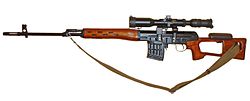 |
Iranian version of the SVD platform.[23] An upgraded variant was unveiled on 12 December 2016.[24] | |
| Siyavash | 7.62×51mm Sniper rifle |
Domestically produced lightweight sniper weighing 6.5 kg (14 lb) loaded.[25] | ||
| Taher | 7.62×51mm Sniper rifle |
 |
Domestically developed sniper rifle with maximum range of 1200 m.[24] | |
| Hovaza | 12.7×99mm Sniper rifle Anti-materiel rifle |
 | Iranian copy of Barrett M82/M107 | |
| Steyr HS .50 Sayyad AM-50 |
12.7×99mm (.50 BMG) Sniper rifle, Anti-materiel rifle |
 |
[26] | |
| Shaher | 14.5×114mm Sniper rifle, Anti-materiel rifle |
|||
| Taktab | 20×102mm Anti-materiel rifle |
Iranian 20 mm anti material sniper rifle.[27] | ||
| Arash | 20×102mm Anti-materiel rifle |
 |
||
| Machine guns | ||||
| RPK | 7.62×39mm Light machine gun |
 |
Iranian version of the RPK platform.[citation needed] | |
| Rheinmetall MGA3 | 7.62×51mm General-purpose machine gun |
 |
Rheinmetall MG3 produced under license.[14] | |
| PKM, PKT | 7.62×54mmR General-purpose machine gun |
 |
Iranian versions of the PKM and PKMT platforms.[13] | |
| Akhgar | 7.62×51mm Rotary cannon, Heavy machine gun |
 |
Locally produced 7.62 mm 6-barrelled rotary machine gun.[citation needed] | |
| W85 | 12.7×108mm Heavy machine gun |
 |
Iranian version of the W85 platform.[28] | |
| MGD 12.7 | 12.7×108mm Heavy machine gun |
 |
Iranian version of the DShkM.[29] | |
| CS/LM2A | 12.7×108mm Heavy machine gun |
 |
Iranian version of the CS/LM2 platform, first unveiled in 2019. The earliest record of its import dating to 2017.[citation needed] | |
| Moharram | 12.7×108mm Rotary cannon, Heavy machine gun |
 |
Locally produced 12.7 mm 6-barrelled rotary machine gun.[30] | |
Explosives
| Model | Type | Origin | Image | Notes |
|---|---|---|---|---|
| Grenade-based weapons | ||||
| Nasir | Automatic grenade launcher |  | 40 mm automatic grenade launcher. | |
| Kaveh-30 | Automatic grenade launcher | 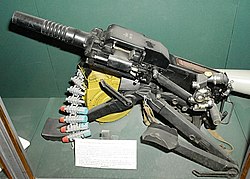 | 30mm automatic grenade launcher. | |
| GP-25 | Grenade launcher | 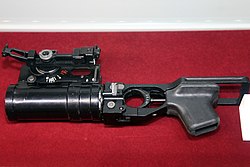 | 40mm under-barrel grenade launcher. Used by Islamic Revolutionary Guard Corps.[citation needed] | |
| M79 | Grenade launcher |  | 40mm shoulder-fired grenade launcher. | |
| Unguided anti-tank weapons | ||||
| Fath | Rocket-propelled grenade | |||
| Nafez | Rocket-propelled grenade | |||
| Zafar | Rocket-propelled grenade | |||
| Saegheh | Rocket-propelled grenade | Improved version of the RPG-7.[31] | ||
| RPG-7 | Rocket-propelled grenade launcher |  | [32] | |
| RPG-29 Ghadir | Rocket-propelled grenade launcher |  | [33] | |
| Type 69 RPG | Rocket-propelled grenade launcher |  | Chinese copy of Russian RPG-7.[citation needed] | |
| SPG-9 | Recoilless rifle |  | [34][35] | |
| M40 | Recoilless rifle |  | [35] | |
| Model | Type | Years of production | Origin | Image | Notes |
|---|---|---|---|---|---|
| Guided anti-tank weapons | |||||
| Saeghe 1/2 | Anti-tank guided missile |  | Reverse engineered and upgraded M47 Dragon.[36][37] | ||
| Toophan Toophan 2 Toophan 2B Toophan 2M Toophan 3 Toophan 4 Toophan 5 Toophan 6 Toophan 7 |
Anti-tank guided missile | Entered production 1987/1988. Revealed 2000. N/A N/A Introduced 2016 First shown to the public in 2017 but in use since at least 2015. Began development in 2002 and entered production in 2010. Shown to the Public in 2017 Planned Variant, currently in development. |
 |
Considered to be the BGM-71A TOW clone,[38] the Toophan-1's payload is a 3.6 kg HEAT warhead. the top speed 310 m/s. Toophan-1 marketing material claims a hit probability of 96%.[39] The Toophan 2 is a derivative of BGM-71C TOW missile with a tandem HEAT warhead; possibly incorporates elements of BGM-71E TOW 2A missile.[40] The Toophan 2B is an upgraded model of the Toophan 2 with a heavier warhead.[citation needed] The Toophan 2M is an upgraded model of the Toophan 2B equipped with a tandem-warhead.[41] The Toophan 3 is a reverse-engineered American BGM-71F TOW 2B top-attack missile.[42] The Toophan 4 is a variant of the Toophan family which is equipped with a thermobaric fuel-air warhead.[43] Considered the premier Toophan variant,[42] the Toophan-5 has laser guidance, tandem-warhead[44] and canards.[citation needed] As a laser-riding missile, it uses a different launcher. Not a copy of any TOW variant.[citation needed] The Toophan 6 is a variant of the Toophan family which is equipped with an anti-bunker thermobaric warhead[45] and is said to be laser-riding.[citation needed] The Toophan 7 is a planned variant of the Toophan family, it's equipped warhead is unclear some sources claim it is perhaps fragmentation thermobaric.[citation needed] | |
| Qaem Qaem-M |
Anti-aircraft missile | Entered mass production in 2009 |  |
The Qaem is an Iranian SACLOS beam-riding SHORAD surface-to-air missile. With a range of six kilometers and a maximum altitude of two kilometers, the Qaem is intended for use against unmanned aerial vehicles and low flying or stationary helicopters. The Qaem is a development of the Toophan missile, hence why they are identical in appearance. The missiles can be used by Ghods Mohajer unmanned aerial vehicles.[46] The Qaem anti-aircraft missile uses a laser guidance system.[47] Iran also produces a variant, the Qaem-M, which adds a proximity fuse.[48] | |
| Dehlavie | Anti-tank guided missile |  | Iranian copy of Kornet.[49][50] Available as Pirooz vehicle-mounted weapon station.[51] | ||
| Almas | Anti-tank guided missile |  | Ground-launched version the air-launched Almas, top attack weapon with a range of 8 km.[citation needed] Unlicensed clone of Israeli Spike.[52] | ||
| Raad | Anti-tank guided missile |  | Manufactured in Iran under the name Raad.[citation needed] | ||
| 9K111 Fagot | Anti-tank guided missile |  | |||
| 9M113 Konkurs Towsan-1 | Anti-tank guided missile |  | Built as Towsan-1 or M-113 in Iran.[citation needed] | ||
| 9K115-2 Metis-M | Anti-tank guided missile |  | |||
Vehicles
Summarize
Perspective
Combat vehicles
| Model | Type | In service | Acquired | Origin | Image | Notes |
|---|---|---|---|---|---|---|
| Main battle tanks 1,613+ | ||||||
| Karrar | Main battle tank | 100> | 2021–present |  | Production begun, 800 planned by end of 2021.[53] | |
| T-72S T-72 Rakhsh |
Main battle tank Main battle tank |
565[54] N/A |
1994–1999 2010s |
  |
Iran produced and received T-72S tanks under licence from Russia from 1993-2012, received 104 T-72M1 tanks from Poland from 1994-1995 and 37 T-72M1 tanks from Belarus starting in 2000.[55] Possible unlicensed production.[citation needed] 1,500 T-72S were ordered/built. Unknown amount of T-72M upgraded to Rakhsh standard, and hundreds of less capable T-72M/M1. T-72 Khorramshahr fitted with T-80UD welded turret and using Kontakt-5 ERA, didn't enter service.[56] | |
| Zulfiqar MBT 1 Zulfiqar MBT 3 |
Main battle tank | 100 N/A |
1994 – Unknown 2000s 2011 – Unknown |
  |
Based on M60. Featuring EFCS-3 fire control system and carousel autoloader. The Zulfiqar 3 is the latest model in the family which has been heavily modernized with advanced technologies and armaments. It features considerable upgrades to the fire control system, chassis, engine and main gun. The new variant is equipped with the 2A46 125 mm smoothbore cannon, a laser rangefinder, RAM camouflage and a new fire control system. It is also fitted with a reinforced turret and the wheels are covered by an armoured skirt.[57][58] | |
| T-72Z Safir-74 T-55 |
Main battle tank | 540[54] | 1996–present 1945–1958 |
 | The T-72Z Safir-74 is a modernized model of the T-55 tank.[59] | |
| Chieftain Mobarez |
Main battle tank | 100[54] | 1971-1979 | 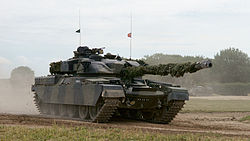 |
707 Mk-3P and Mk-5P, 125–189 FV-4030-1, 41 ARV and 14 AVLB obtained before the 1979 revolution. Further planned deliveries of the more capable 4030 series were cancelled at that point. 100 in service as of 2005. Many others upgraded to Mobarez.[60][56] | |
| T-62 | Main battle tank | 75+[54] |  |
|||
| M60A1 Samsam | Main battle tank | 150[54] | 1969-1970 |   |
Some sources claim ~150 M60.[61] Locally modernized as the Samsam.[62][56] A new modernization package called the Soleiman-402 was unveiled in 2024, Brigadier General Kioumars Heydari, Commander of the Army Ground Forces, confirmed that all M60 tanks within the Iranian Army's inventory would be upgraded to the Soleiman-402 standard.[63] | |
| M47 Patton M48 Patton |
Main battle tank | 168[54] |  |
|||
| Armoured vehicles 1,240+ | ||||||
| Tosan | Light tank | N/A |  |
Tosan is a domestically produced light tank, based on the FV101 Scorpion. | ||
| FV101 Scorpion | Combat vehicle reconnaissance | 80[54] |  |
|||
| Sayyad | Armored fast attack vehicle | N/A |  |
Can be armed with 77 mm rockets, anti-tank guided missiles, and various chainguns.[56] | ||
| Boragh | Armoured personnel carrier | 140[54] | 1980-1988, 1997 |  |
Can be armed with DSHK Heavy Machine guns or ZU-23-2 | |
| Makran IFV | Amphibious | N/A |  |
Most BTR-50s will be upgraded or are being upgraded to Makran IFV (BTR-50 with new electronics, new armor, and an unmanned turret with a 30mm auto-cannon).[56] | ||
| BMP-1 | Infantry fighting vehicle | 210[54] |  |
|||
| BMP-2 | Infantry fighting vehicle | 400[54] | 1991–2001 (may be present, as production is alleged to have not ended) |  |
1,500 ordered in 1991 from Russia and 413 were delivered between 1993 and 2001 of which 82 were delivered directly by Russia and 331 were assembled in Iran.[64] 100 were in service in 1995, 140 in 2000 and 400 in 2002, 2005 and 2008.[65] 400 are currently in service.[66] Some sources claim that production is ongoing.[citation needed] | |
| M113½ C&R Lynx | Reconnaissance armoured fighting vehicle | N/A |  |
[56] | ||
| M113A1/M577 | Armoured personnel carrier | 200[54] | 1966-1978 |  |
||
| Rakhsh | Armoured personnel carrier | N/A[54] |  |
Multiple variants, some with upgraded armor.[56] | ||
| BTR-50 BTR-60 Haidar |
Armoured personnel carrier | 300+[54] | 1966–2017 (BTR-80) | 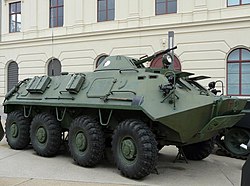  |
KPVT 14.5 mm machine gun replaced with DShKM 12.7 mm machine gun or ZSU-23 gun on some vehicles. anti-tank guided missile launchers added to some vehicles. Sedad BTR-82 variant of BTR-60 with ZU-23-2.[56] Heidar 6 variant with BMP-1 turret installed onto BTR-60, Heidar 7 variant with ERA bricks, modified interior, and new turret installed with a single 23 mm gun.[56] Heidar-5 mine layer variant and Shahram NRBC detection vehicle variants of BTR-60.[56] | |
| Pirooz | Anti-tank missile carrier | N/A | 2021 |  |
Based on Aras tactical vehicle. The vehicle is equipped either two or four Dehlavieh anti-tank missile system.[67] | |
| EE-9 Cascavel | Armored car | 35[54] |  |
According to Global Security, 35 are in service.[57] | ||
| EE-11 Urutu | Armoured personnel carrier | 50 |  |
[68][69][70] | ||
| Toofan | MRAP | N/A[54] |  |
[56] | ||
| Ra'ad | MRAP | N/A |  |
[71] | ||
| Kia | Infantry mobility vehicle | N/A |  |
[72][73] | ||
| Fateq | Infantry mobility vehicle | N/A |  |
[74][75] | ||
| Special military equipment | ||||||
| Murmansk-BN | Electronic warfare system | N/A | 2024–present |  |
[76] | |
Non-combat vehicles
| Model | Type | Quantity | Acquired | Origin | Image | Notes |
|---|---|---|---|---|---|---|
| Utility vehicles | ||||||
| Safir Jeep | Multipurpose military vehicle | 36,000+[77][78] | 2008 |  | Yearly production capacity of 5000 vehicles.[77][79] | |
| Samandar | Light attack vehicle | 1000+ |  |
[80][81][56] | ||
| Kaviran / Sepehr | Multipurpose utility vehicle | 900 to 1800+ |   |
Also used as military ambulances[56][82][83] | ||
| Aras/Aras 2 | Multipurpose military vehicle | 2000+ |  |
Iranian-made tactical vehicle based on F-4.5 Toyota chassis.[84][85][86][56] | ||
| Aras 3 | Multipurpose military vehicle | 1000+ |  |
[87] | ||
| Ranger | Light attack vehicle | Unknown |  |
[88][89][56] | ||
| M548 | Cargo carrier | Unknown |  |
[56] | ||
| High Mobility Multipurpose Wheeled Vehicle | Light utility vehicle | 29 | 2021 |  |
Some examples were taken from fleeing ANA troops after 2021 Taliban offensive and put to service with Artesh Ground Forces 55th Airborne Brigade after facelift.[90][91] | |
| Trucks | ||||||
| Neynava | Lightweight truck | 15,000+ |  | [56] | ||
| Mercedes-Benz L-series truck | Truck | Unknown |  |
[92][56] | ||
| Navistar 7000 series | Heavy truck | Unknown |  |
Ex-Afghan National Army trucks that were evacuated to Iran in 2021[93] | ||
| Mercedes-Benz Actros | Heavy truck | 1000+ |  |
[56] | ||
| MAN KAT1 | Heavy truck | Unknown |  |
Also used as a mount for the 122mm HM-20 Multiple Rocket System [94] | ||
| KrAZ-6322 | Heavy truck | Unknown |  |
|||
| KrAZ-5233 | Heavy truck | Unknown |  |
|||
| KamAZ-43114 | Heavy truck | 2500+ |  |
Licensed production under Rakhsh Khodro Diesel[95][96] | ||
| IVECO Eurocargo | Heavy truck | Unknown |  |
Licensed production under Zamyad[97][98] | ||
| Hyundai Mighty | Light truck | 2000+ |  |
[56] | ||
| Engineering vehicles | ||||||
| Shahram NRBC | CBRN defense | Unknown |  |
|||
| Husky VMMD | VMMD | Unknown |  |
Dozens of units are in service, a specific number is unknown. | ||
Artillery
| Model | Type | Quantity[citation needed] | Acquired | Origin | Picture | Notes |
|---|---|---|---|---|---|---|
| Mortars | ||||||
| 37mm Marsh Mortar | 37mm mortar | 975+ | ||||
| HM 12 | 60 mm mortar | 138+ |  | |||
| HM 13 | 60 mm mortar | 478+ | ||||
| HM 14 | 60 mm mortar | 280+ | ||||
| HM 15 | 81 mm mortar | 57+ | ||||
| HM 16 | 120 mm mortar | 86+ |  | |||
| Razm Mortar | 120 mm mortar | 38+ |  | [citation needed] | ||
| Vafa Mortar | 160 mm mortar | 78+ |  | [85][86] | ||
| Multiple rocket launcher system 1,467+ | ||||||
| Type-63 | 107mm MRL | 700[54] |  |
|||
| Fajr 1 | 107mm MRL | 600[54] | 1986 | Mounted on the Safir | ||
| BM-21 Grad | 122mm multiple launch rocket system | 107[54] | 1978 |  | ||
| Fajr-3 | 240mm multiple launch rocket system | 10[54] | 1994 |  | ||
| Fajr-5 | 330mm multiple launch rocket system | N/A[54] | 1990 |  | ||
| 122mm Hadid/Azrash/Nur | 122mm multiple launch rocket system | 50[54] | 1994 |  | ||
| Self-propelled howitzer 292+ | ||||||
| 2S1 Gvozdika | 122mm self-propelled howitzer | 60[54] |  | |||
| Raad 1 | 122 mm self-propelled howitzer | N/A[54] | ||||
| Raad 2 | 155 mm self-propelled howitzer | N/A[54] | 1997 |  | Based on M109 | |
| M109A1 | 155 mm self-propelled howitzer | 150[54] |  | Remanufactured locally as the Hoveyzeh. | ||
| M107 | 175 mm self-propelled howitzer | 22[54] |  |
|||
| M110 | 203 mm self-propelled howitzer | 30[54] |  |
|||
| M-1978 | 170 mm self-propelled howitzer | 30[54] |  |
|||
| Towed Howitzer 2,030+ | ||||||
| M101A1 | 105mm howitzer | 130[54] |  | |||
| M-56 | 105 mm howitzer | 20[54] |  |
|||
| 2A18M | 122 mm howitzer | 540[54] |  | |||
| 122 mm D-74/Type 60 field gun | 122 mm howitzer | N/A |  | Operated by IRGC-Ground artillery. | ||
| 122mm HM 40 | 122 mm howitzer | N/A |  | Photo may show scale model | ||
| Type-54 | 122 mm howitzer | 100[54] |  | [99] | ||
| M1954 and Type 59 | 130 mm howitzer | 985[54] |  | In 2002, Iran had 1,100 M-46 in conditional use. By 2012 this number has dropped to 985. | ||
| M1955 | 152 mm howitzer | 30[54] |  | |||
| KH179 | 155 mm howitzer | N/A |  | [100][101][102] | ||
| 155mm HM 41 | 155 mm howitzer | N/A |  | |||
| Type 88 | 155mm howtizer | 15[54] |  |
|||
| GHN-45 | 155 mm howitzer | 120[54] |  |
|||
| M114 | 155 mm howitzer | 70[54] |  |
|||
| M-115 | 203 mm howitzer | 20[54] |  | |||
Missiles
Summarize
Perspective
This refers to ballistic missiles and not battlefield systems. Iran's missile forces are under the command of the Revolutionary Guards, under the army's authority. Additional information is available at the article Air Force of the Army of the Guardians of the Islamic Revolution, which force operates Iran's long-range missiles. Iran was reported to have purchased 18 mobile Musudan missiles (the extended range version of Soviet R-27 Zyb) with a 3,200-to-4,000 km range in 2005.[103]
| Model | Type | Quantity | Acquired | Origin | Image | Notes |
|---|---|---|---|---|---|---|
| Anti-ship missiles | ||||||
| Khalij Fars | Anti-ship ballistic missile | N/A |  | Based on Fateh-110[104][105] | ||
| Kowsar 1/2/3 | Anti-ship missile | N/A |  | A copy of Chinese C-701 and TL-10[106] | ||
| HY-2 Silkworm | Anti ship missile | N/A |  | Chinese ASCM | ||
| Nasr-1 | Anti ship missile | N/A |  | A copy of Chinese C-705 and TL-6[106] | ||
| Noor | Anti-ship missile | N/A |  | A copy of Chinese C-801 and C-802 | ||
| Qader | Anti ship missile | N/A |  | an Enhanced, Locally Produced Version of the C-802 Anti-Ship Missile[107] | ||
| Ghadir | Anti-ship missile | N/A |  | |||
| Ra'ad | Anti-ship missile | N/A |  | The missile is a reverse engineered and upgraded variant of China's Silkworm anti-ship missile [108] | ||
| Zafar | Anti-ship missile | N/A |  | Light ASCM for IRGC navy[109] | ||
| Abu Mahdi | Anti ship missile | N/A |  |
Long-range ASCM[110] | ||
| Ballistic missiles | ||||||
| Tondar-69 | Rocket artillery | N/A |  | |||
| Oghab | Rocket artillery | N/A | 1985–present |  | An upgraded Chinese Type-83 rocket, created with Chinese assistance. | |
| Naze'at | Rocket artillery | N/A | 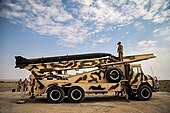 | |||
| Zelzal | Tactical ballistic missile | 3800+ |  | [111] | ||
| Fateh-110 | Tactical ballistic missile | 4500+ | 2002–present |  | [112] | |
| Fath 360 | Tactical ballistic missile | 100+ | 2022–present |  |
[113] | |
| 9K720 Iskander | Mobile short-range ballistic missile | N/A |  |
[110] | ||
Air defense
Aircraft
Summarize
Perspective
The IRIA Ground Forces operates an army aviation component comprising the following aircraft and UAVs:
Helicopters
| Aircraft | Origin | Type | Variant | Quantity | Years | image | Notes |
|---|---|---|---|---|---|---|---|
| Attack helicopters | |||||||
| HESA Shahed 285 | light attack/reconnaissance | N/A | 2009 | 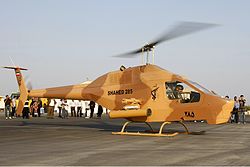 |
Can carry ATGMs, anti ship missiles, and air to air missiles. | ||
| IAIO Toufan | Attack | Toufan I/Toufan II | 50[54] | 2010 |  |
The IAIO Toufan or Toophan (Persian: توفان, "typhoon") is series of combat helicopters by the Iran Aviation Industries Organization. Based on the US-built AH-1J International with New laser system Rocket-launching digital control system Multi-display monitor, and Central smart arms management system | |
| Panha 2091 | Attack | AH-1J International | 13[114] | 1998 |  |
||
| Utility helicopters | |||||||
| HESA Shahed 274 | light utility helicopter. | N/A | 2000 | ||||
| HESA Shahed 278 | Light utility | N/A | 2005 |  |
Iran's Shahed Aviation Industries Research Center plans to produce several variants of Shahed, according to sources. The first platform was the Shahed-278 (Oh-78), described as a light reconnaissance helicopter, armed with weapons and sensors. Test flights of the Shahed-278 (Oh-78) began in 2005 | ||
| Mil Mi-17 | Medium-lift transport | Mi-8/17 | 20[54] |  |
Used by Iran Islamic Revolutionary Guard Corps navy and Ground Forces of the Islamic Revolutionary Guard Corps | ||
| Agusta Bell 206 | Light utility/trainer | AB 206 | 10[54] |  |
Licence-built in Italy. | ||
| Agusta-Bell 212 | Utility | AB-212 | N/A |  |
Licence-built in Italy | ||
| Bell 214 | Utility/SAR | Bell 214C/214A | 49[54] |  |
|||
| Bell UH-1N Twin Huey | Utility | Bell-205A | 68[54] | 1970 |  |
In addition to the Air Force, the helicopter is used by the Iranian Revolutionary Guards and the Iranian police | |
| Boeing CH-47 Chinook | Heavy-lift transport | CH-47C | 20[54] |  |
|||
Transport aircraft
| Aircraft | Type | Versions | In service | Origin | Photo |
|---|---|---|---|---|---|
| Dassault Falcon 20 | VIP transport | Falcon 20E | 1[54] | France |  |
| Fokker F27 Friendship | Tactical transport | F27-400M F27-600 | 2[54] | Netherlands |  |
| Aero Commander | Utility transport | 690 | 4[54] | United States |  |
| Cessna 185 | Transport | Cessna 185F | 10[54] | United States |  |
Unmanned aerial vehicles
| Model | Type | Quantity | Acquired | Origin | Image | Notes |
|---|---|---|---|---|---|---|
| Sofreh Mahi | Stealth unmanned combat aerial vehicle | - |  | Under development | ||
| Karrar | Unmanned combat aerial vehicle | + | 2010 |  | [115][116] | |
| Ababil | Unmanned aerial vehicle | + | 1986 |  | A wide number built in several different variants including the tactical Ababil-5 for medium-range reconnaissance and surveillance, the Ababil-T for short/medium-range attack, and also the Ababil-B and -S[117] | |
| Arash | Loitering munition | Thousands | 2020 |  |
||
| Mohajer 1/2/3/4/5 | Unmanned aerial vehicle | 300+ | 1980s |  | [35][118] | |
| Mohajer 6 | Unmanned combat aerial vehicle | 221+ | 2017 |  |
[119] | |
| Raad 85 | Unmanned aerial vehicle | + |  | Suicide drone[118] | ||
| Ra'ad | Unmanned aerial vehicle | + | With offensive capabilities[120][121] | |||
| Nazir | Unmanned aerial vehicle | + | [120][121] | |||
| Hod Hod | Unmanned aerial vehicle | + | [122] | |||
| Saegheh 1 | Target drone | 90 | 2013 |  | [123] | |
| Saegheh 2 | Unmanned combat aerial vehicle | 50+ | 2014 |  | Based on, but smaller than and substantially different from, the Lockheed Martin RQ-170 Sentinel | |
| Simorgh | Unmanned combat aerial vehicle | ? | 2014 |  | Full-size copy of the American RQ-170 UAV | |
| Yasir | Unmanned aerial vehicle | Hundreds | 2013 |  | In November 2013 a Yasir UAV was shown flying over Damascus, Syria in support of Syrian Arab Army forces fighting against rebels.[118][124] | |
| Shahed 129 | Unmanned combat aerial vehicle | 42+ | 2012 |  | Medium-altitude long-endurance combat drone, counterpart of the American MQ-1 Predator. | |
| Mohajer 10 | Unmanned combat aerial vehicle | 1+ | 2023 |  |
The Mohajer 10 is fitted with surveillance and electronic warfare capabilities, it is capable of flying at speeds of up to 130 mph, and can carry several kinds of armament with a maximum payload of over 650 pounds.[125] | |
| Shahed 136 | Loitering munition | Thousands | 2020/2021 |  |
||
| Shahed 149 Gaza | Unmanned combat aerial vehicle | 3+ | 2021 |  |
High-altitude long-endurance combat drone, counterpart of the American MQ-9 Reaper. | |
| Hamaseh | Unmanned aerial vehicle | 30 | 2013 |  | A medium-range drone, capable of carrying air to ground missiles | |
| H-110 Sarir | Unmanned combat aerial vehicle | 10+ | 2013 |  | Capable of carrying air-to-air missiles | |
| Fotros | Unmanned combat aerial vehicle | 3+ | 2013 |  | Unmanned combat aerial vehicle with range of 2000 km, flight ceiling of 25000 ft and 16–30 hours flight endurance, armed with missiles.[126] | |
| Kaman 22 | Unmanned combat aerial vehicle | ? | 2021 | Wide-body combat drone with a range of 3000 km, a flight duration of over 24 hours and armed with variety of weapons.[127] | ||
| MQM-107 | Target drone | 180 | 1970s |  | [116] | |
| Meraj-532 | Unmanned aerial vehicle | ? | 2023 | Suicide drone to be used in Islamic Revolutionary Guards. May still be in test phase.[128] |
See also
Lists of equipment
- List of military equipment manufactured in Iran
- List of aircraft of the Iranian Air Force
- List of aircraft of the Aerospace Force of the Islamic Revolutionary Guard Corps
- List of equipment of the Islamic Republic of Iran Air Defense Force
- List of current ships of the Islamic Republic of Iran Navy
- List of equipment of the Navy of the Islamic Revolutionary Guard Corps
- Tanks of Iran
References
External links
Wikiwand - on
Seamless Wikipedia browsing. On steroids.




